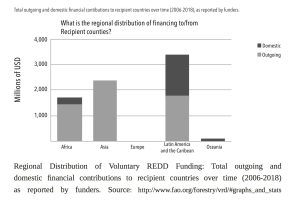12
According to the World Bank, “The Africa Carbon Forum 2011, held in Marrakesh, Morocco, saw more than 1,000 participants exploring new carbon finance opportunities in Africa.”86 By 2011, more than 7.7 billion dollars had already been committed (but not necessarily actually delivered) for REDD by donor countries,87 and more than $35 million a year for REDD is being dished out by global foundations.88 Other funding sources for REDD includes UN-REDD, UNEP, World Bank and its diverse carbon project programs. It is difficult to ascertain what percentage of these funds goes to Africa since the voluntary and mandatory markets do not compile such data. Funding for REDD in Africa includes $22.3 million disbursed from UN-REDD to five African countries that have national programs, namely the (Congo, DRC, Nigeria, Tanzania and Zambia). In 2013, the Congo Basin Forest Fund, many of whose projects are REDD, aspired to disburse 17 million Euros.89
The following chart shows Voluntary REDD Funding as reported by funders, which may overlap with the amount from the Congo Basin Forest Fund to some degree. The amounts for each country presented online in the Voluntary REDD Funding map have been registered and tallied in the accompanying Voluntary REDD Chart. The total amount of voluntary REDD Funding for more than 40 African countries is $1.192 billion. The $198.68 million for the Democratic Republic of Congo is the highest amount followed by $135.12 million for Tanzania, where there have been scandals about the REDD corruption and conflicts; 90 and $55.16 million for Mozambique. It is also interesting that so many arid countries are funded, which may point to landscape REDD including carbon sequestration from deserts.
| Country | Voluntary REDD Funding (millions of dollars) |
| Angola | 0.45 |
| Algeria | 0.63 |
| Benin | 24.14 |
| Botswana | 0.47 |
| Burkina Faso | 94.28 |
| Cameroon | 48.51 |
| Central African Republic | 36.26 |
| Chad | 13.58 |
| Congo | 23.26 |
| Cote d’Ivoire | 45.48 |
| DRC | 198.68 |
| Ethiopia | 51.94 |
| Equatorial Guinea | 6.03 |
| Gabon | 28.18 |
| Ghana | 90.96 |
| Guinea | 0.8 |
| Guinea Bissau | 1.6 |
| Kenya | 35.18 |
| Liberia | 26.76 |
| Niger | 10.1 |
| Nigeria | 24.43 |
| Madagascar | 13.6 |
| Malawi | 36.13 |
| Mali | 32.08 |
| Mauritania | 9.07 |
| Morocco | 28.9 |
| Mozambique | 55.16 |
| Namibia | 0.76 |
| Rwanda | 27.11 |
| Senegal | 19.04 |
| São Tomé and Principe | 6.05 |
| Sierra Leone | 8.31 |
| South Africa | 0.32 |
| Sudan | 4.1 |
| Uganda | 8.83 |
| Tanzania | 135.12 |
| Togo | 4.79 |
| Tunisia | 12.73 |
| Zambia | 28.68 |
| Zimbabwe | 5.8 |
| TOTAL | 1.1925 billion dollars |
As the following graphic of the Regional Distribution of Voluntary REDD Funding shows, Africa has received less voluntary funding than Asia or Latin America. The voluntary funding from domestic sources for Latin American REDD is significant, while Asia and Africa have none. The lesser sum received by Africa does not necessarily mean that REDD in Africa is implemented in a smaller landmass, since costs for doing REDD in Africa may be lower than the other regions.

